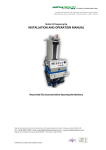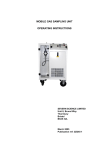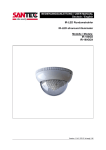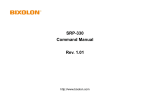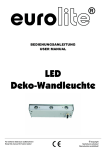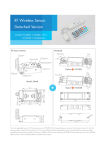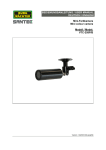Download ELECTRIC STILL - metal, 2L / hr.
Transcript
INSTRUCTION SHEET ELECTRIC STILL - metal, 2L / hr. Cat: CH3860-001 1800 Watt DESCRIPTION: The IEC ‘Water Still’ has a power requirement of 220/240V.AC. 7.5 amp. 1800 Watt. At full voltage, this compact metal Water Still can deliver distilled water at the rate of greater than 2 litres per hour. CH3860-001 Electric Still, 2L/Hr Physical size: 160x285mm DxH Approx. rate of cooling water: 500ml/minute Approx. rate of distillate: 2.1L/hr. Weight: 3.3kg. INDUSTRIAL EQUIPMENT & CONTROL PTY.LTD. 61-65 McClure St. Thornbury. 3071 Melbourne. Australia Tel: 61 (0)3 9497 2555 Fax: 61 (0)3 9497 2166 ch3860-001.doc 3-Jul-06 1 INSTRUCTION SHEET DESCRIPTION: The Still has three main parts: • The main body in which the water is boiled. A ‘self leveller’ is fitted to the side of the main body to maintain water level during boiling. • The splash baffle which has a crosswise strip to prevent unwanted splash from the boiling water rising into the condenser. It seals to the main body by an ‘O’ ring. • The condenser which seals to the baffle also by an ‘O’ ring. The condenser has a water control valve, a water outlet pipe and a condensate outlet spout. The whole assembly is clamped down firmly to the main body by the flat knurled knob on the swinging handle. NOTE: On our late model, the two ‘O’ rings are the same size and can be interchanged. Older models had different sized ‘O’ rings. ASSEMBLY OF THE STILL: • • • • • Take the main body and stand it on a bench. Take the splash baffle with the plate across its middle and slightly stretch one ‘O’ ring around the open mouth of the splash baffle and place it into the mouth of the main body so that the ‘O’ ring seals to the upper edge of the main body. Press the other ‘O’ ring on to the small ledge on the upper side of the splash baffle and invert the condenser over the splash baffle until the ‘O’ ring on the splash baffle is pressing against the corner inside the condenser. Place the large metal washer on the water outlet pipe and guide the water outlet pipe into the self leveller on the side of the main body so that the washer rests loosely on the upper face of the self leveller. The ‘O’ ring inside the mouth of the condenser should now seal to the small ridge around the outside of the splash baffle. A sealed chamber is now formed where the condenser seals to the splash baffle. This captures the distilled water before it flows out the condensate outlet pipe. The assembly is held tightly by swinging the black handle to a vertical position and spinning the knurled knob down so that the knob presses the highest point of the conical condenser downwards. Tighten the knurled head firmly to the condenser to make the ‘O’ rings seal. HOW IT WORKS: The main body is filled with water up to the level of the overflow pipe and the water is heated until it boils. The condenser is fed with cold water from the tap at a sufficient flow rate to keep the condenser surface cool. This water flow is controlled by the valve provided. The steam rises from the boiling water, passes around the splash baffle and enters the chamber below the cool condenser. The steam immediately condenses to become distilled water and the droplets run down the inner sloping face of the condenser to accumulate at the outer edge where the condenser seals to the splash baffle. The condensate outlet spout passes the condensate through the wall of the condenser to be collected in a distilled water storage bottle which is normally placed on the floor. INDUSTRIAL EQUIPMENT & CONTROL PTY.LTD. 61-65 McClure St. Thornbury. 3071 Melbourne. Australia Tel: 61 (0)3 9497 2555 Fax: 61 (0)3 9497 2166 ch3860-001.doc 3-Jul-06 2 INSTRUCTION SHEET INITIAL FILLING: Connect the cold water supply tap to the inlet fitting on the flow control valve. Use a suitable high pressure rubber hose clamped tightly to the fitting with a hose clip or similar. The self leveller device on the main body has an overflow tube protruding from its side. Simply push a plastic or rubber hose over the overflow fitting and run to a sink or drain. Turn on the water at the tap and adjust the flow valve to obtain a gentle steady flow. Water should be seen to flow from the upper condenser assembly down into the self-leveller on the side of the main body. After a few moments, water should be seen to flow from the overflow pipe to the sink. While the water is flowing into and out of the self-leveller, the main tank is gradually filling up to the level of the overflow pipe. This tank filling process might take about 4 to 5 minutes. For faster filling, loosen the clamping handle, swing it out of the way and remove the condenser and splash baffle from the main body. Fill the Still from the water tap up to the level of the self leveller. Install the splash baffle and condenser as described above and clamp firmly with the knob on the handle. Turn on the mains water and adjust the water flow through the condenser until the overflow is running at about 300 to 500ml per minute. Turn electric power on and the small red pilot light will illuminate. When the water is boiling, hot condensate will be seen to dribble from the outlet spout. This spout may be connected by a flexible tube to a clean distilled water storage bottle placed on the floor. IMPORTANT NOTE: Care must be taken not to block or kink the outlet hose and the outlet must NOT be immersed under water. Restriction of water and air flow from this condensate tube may cause a slight back pressure which can slow down or stop the distillation, or in the worst case, can push the water level in the still body downwards until it becomes empty and trips the thermal protection device. MORE NOTES: Leaks: If water is evident running down the outside of the Still, it is probably due to either of the two ‘O’ rings not sealing. Check for damage to the still body or sealing surfaces, check the assembly of the Still and the tightness of the clamping knob on the handle. Water flow through the condenser: Do not control the water flow through the condenser by using the water tap. Always open the supply water tap generously and control the flow by using the fine control valve on the still. When the cold water flow through the condenser is correct, the temperature of the outer surface of the condenser can be gently warm to the touch but not hot. If steam puffs from the condensate outlet pipe and hose it means the volume of steam cannot fully condense because the cold water flow through the condenser is probably insufficient. If this occurs, the condenser will feel very warm or hot. Increase the cold water flow. Typical water flow through the condenser would be about 300 to 500ml per minute. INDUSTRIAL EQUIPMENT & CONTROL PTY.LTD. 61-65 McClure St. Thornbury. 3071 Melbourne. Australia Tel: 61 (0)3 9497 2555 Fax: 61 (0)3 9497 2166 ch3860-001.doc 3-Jul-06 3 INSTRUCTION SHEET Low water level protection (boil dry protection): The electric Still is protected against boiling dry by a special ‘press button reset’ safety heat sensor in the base that isolates the electric power. To reset this safety device, carefully lift the Still and press the red button visible through the base of the Still. This safety device should not be reset until water is again present in the main body. Be sure that the water level in the main body is definitely above the heating element before resetting. Care of the equipment: • • • Keep the Still clean and shiny. The shiny surface improves efficiency by reducing heat loss to the atmosphere. Occasionally inspect inside the Still body for deposits of calcium and minerals on the element and in the Still body itself. This build-up of deposits will occur more rapidly in areas with ‘hard’ water (high mineral content) or bore water and the like. To dissolve deposits, fill the Still with a mild acid vinegar solution (or a commercially available scale remover) and allow to stand until the alkaline deposits are dissolved away. If necessary use a stronger acidic solution and repeat the exercise as required. Do not use strong acid or the plating inside the Still body will be affected. Inspect the ‘O’ rings and, if cracked or split, replace them. To withstand constant exposure to steam, use only original spare parts. Check that the sealing surfaces are smooth and dint free. If the ‘O’ rings cannot seal fully to the adjacent metal parts, leaks will be evident and the Still efficiency will be poor. NOTE for safety testers: The electric still element is the ‘tubular sheathed type’. The insulation resistance of a sheathed element must exceed 10,000 ohms to earth. Refer AS/NZS 3000:2000 Para 1.11.2.3 Designed and manufactured in Australia INDUSTRIAL EQUIPMENT & CONTROL PTY.LTD. 61-65 McClure St. Thornbury. 3071 Melbourne. Australia Tel: 61 (0)3 9497 2555 Fax: 61 (0)3 9497 2166 ch3860-001.doc 3-Jul-06 4




